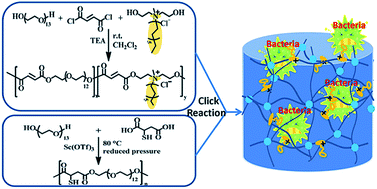In this work, Zhu and co-workers prepared fully biodegradable antimicrobial hydrogels via a thiol–ene “click” reaction under human physiological conditions using multifunctional poly(ethylene glycol) (PEG) derivatives as precursors. Water soluble and degradable PEG derivatives with multi-enes and multi-thiols, respectively, were synthesized by polycondensation of oligo(ethylene glycol) (OEG) with “clickable” monomers. Ammonium groups with long alkyl chains were incorporated into one of the precursors covalently, using dodecyl bis(2-hydroxyethyl) methylammonium chloride as a comonomer. These types of cationic PEG-type hydrogels showed strong antibacterial abilities against both Gram- negative and Gram-positive bacteria due to the ammonium moieties. Moreover, the hydrogel with fewer ammonium moieties still possessed significant antibacterial abilities, but low toxicity, and has the potential to be used as a medical material.
Fully biodegradable antibacterial hydrogels via thiol–ene “click” chemistry by Hong Du, Guangyu Zha, Lilong Gao, Huan Wang, Xiaodong Li, Zhiquan Shena and Weipu Zhu, Polym. Chem. 2014, 5, 4002-4008.
Julien Nicolas is a web-writer and advisory board member for Polymer Chemistry. He currently works at Univ. Paris-Sud (FR) as a CNRS researcher.











